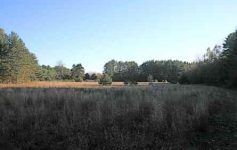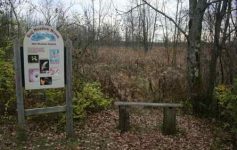- Town of Northumberland
- Size: Few acres
- Scenery: Farmland
- Terrain: Steep to the top.
Trip Tip: Historic Site
Visit Stark’s Knob and brush up on your American history while learning some geology of the local area. This has been a natural history site of the NYS museum since 1916. Since then Stark’s Knob has seen much controversy and was almost sold to private individuals several times. In 2000 an outdoor exhibit was created and will hopefully be maintained well into the future. Walking up to the top of the knob is exciting and rewards you with beautiful views of the Hudson River and the Green Mountains of Vermont.
History
This volcanic basalt pillow was a strategic location during the Revolutionary War. In October of 1777 General John Stark held the position between Stark’s Knob and the Hudson River to prevent the British and German forces from retreating north to Fort Ticonderoga, after being defeated at the Battles of Saratoga. “This was the springing of the trap about which General Riedesel had talked, the corking of the bottle which sealed the fate of the British army…” From John Henry Brandow’s The Story of Old Saratoga and History of Schuylerville, published in 1919.
Geology
Stark’s Knob was formed 460-440 million years ago during the middle of the Ordovician Age. A volcanic arc pushed west into Vermont and eastern New York causing the continent to buckle in front of it. Cracks (vents) opened in the earth’s crust and basalt lava flowed out of the cracks into the shallow sea that covered the area. Fossils found in the basalt pillows at Stark’s Knob are evidence of this geologic history.
Similar basalt pillows of the same age have been discovered to the north in western Newfoundland and to the south in New Jersey and Pennsylvania. These discoveries conclude that Stark’s Knob was part of the first orogeny (mountain building episode) in the Appalachian Mountains.
Directions: ROUTE 4
From Saratoga Springs drive east on Rte 29 to Schuylerville. When you come to the traffic light in Schuylerville, go north one mile on Rte 4. The parking area is on the left. From the parking area, walk up the hill to the entrance of the park. To reach the top of the knob, continue up the road a few hundred yards to a path on the right.


